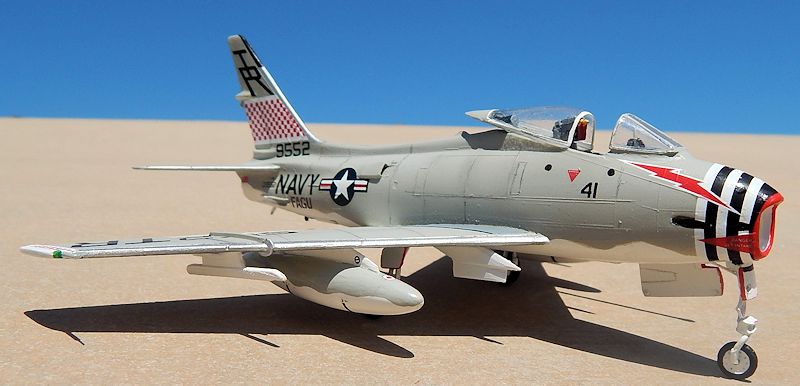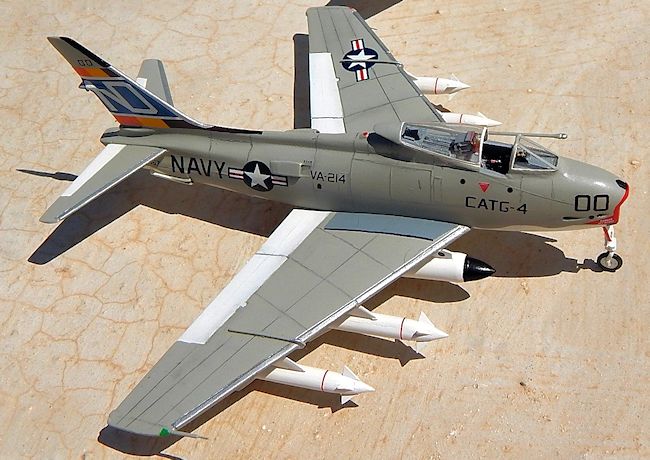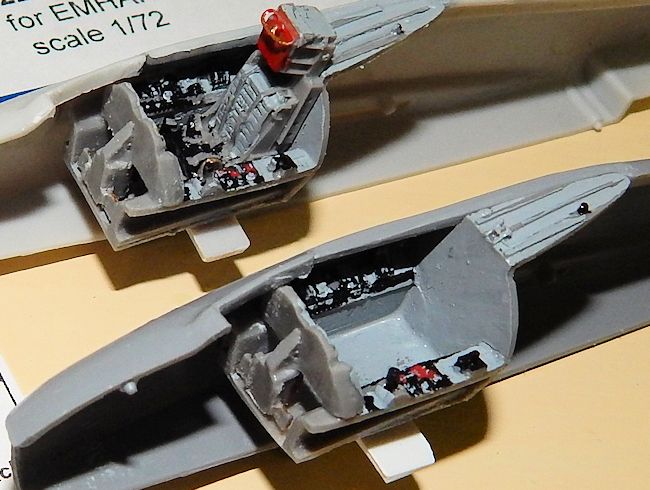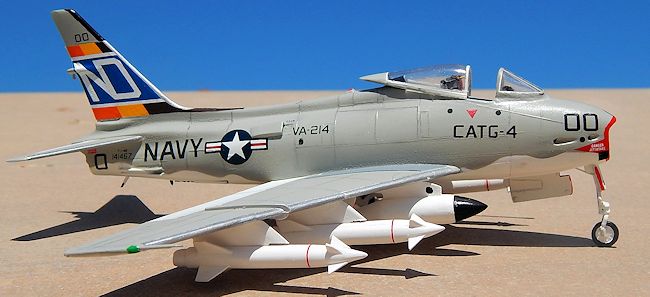
Emhar 1/72 FJ-4 Fury
| KIT #: | 1001 |
| PRICE: | 3.50 euros |
| DECALS: | Two options |
| REVIEWER: | Carmel J. Attard |
| NOTES: | Pavla cockpit set used |

| HISTORY |
The FJ-4 prototypes were complete
redesigns by North American engineers and these consequently differed from the
earlier FJ-2 and FJ-3. The first of the prototypes made its maiden flight on 28th
October 1954 and the first production machine came off Columbus assembly line in
February 1955.
The
new design had smaller fin, and fitted with a shorter redesigned rudder and a
fuselage that was deeper and shorter than the previous Fury versions. It also
had a dorsal spine running all along on top of the fuselage. There was also
increase in cockpit armor plating. There was increase in wingspan by 2 ft which
was also reduced in thickness and have a multi spar design. The wing had a
mid-span aileron, high lift flaps and leading edge slots.
The FJ-4 carried
four underwing pylons with the inboard staion being capable of carrying drop
tanks or up to
 2,000 lbs
of ordnance. All 4 stations were wired to carry air-to-air Sidewinder missiles.
The FJ-4 carried 50% more fuel than earlier FJ-3 giving combat range close to
1,500 miles with comparable speed to the FJ-3. It also contained electronics,
which made it capable of carrying an attack in all weather conditions.
2,000 lbs
of ordnance. All 4 stations were wired to carry air-to-air Sidewinder missiles.
The FJ-4 carried 50% more fuel than earlier FJ-3 giving combat range close to
1,500 miles with comparable speed to the FJ-3. It also contained electronics,
which made it capable of carrying an attack in all weather conditions.
The FJ-4 was
equipped within-flight refuelling probe and was often flying in company with the
AJ-2 Savage that served as tanker. The majority of FJ-4s were operated by the
Marine fighter squadrons. Navy utility squadrons also operated a number of
FJ-4s. These carried target-towing reel under the wing inboard pylons. The end
of 1962 has placed FJ-4s out of front line use, operated mainly by reserve
squadrons. Such types were assigned to Naval Reserve Air Units of NAS Memphis
during summer of 1962.
FJ-4B differed
from the FJ-4 in several ways. It featured strengthened wing that could carry 6
underwing ordnance stations, additional speed brakes positioned at the rear of
fuselage which had two external reinforcing channels and extended approximately
half way back under the tail surfaces. These additional speed brakes helped slow
the aircraft considerably at low level, allowing more precise bomb runs.
Following
introduction into fleet services the FJ-4B had a number of changes incorporated
into the aircaft. To extend its range a Buddy refuelling package was designed
that allowed the FJ-4B to take full advantage of its in flight refuelling
capability. The Buddy fuel tank contained hose and drogue refuelling system,
allowing one FJ-4 to refuel another with some 3,000 lbs of fuel. This extended
the receiving aircraft combat radius by 50%. The system was successful and was
put in operational use by VA-151 during June 1958 while deployed aboard USS
Bennington.
More significant
improvement s to the FJ-4Bs was the introduction of the ASM-7 Bullpup missile to
its arsenal. This allowed the aircraft to hit a target with great accuracy while
avoiding heavy ground fire. The 11
 ft long
missile weighed 540 lbs and carried 250 Lbs of warhead. The pilot using a small
control stick directed the missile. The stick transmitted radio signals to the
missile that the pilot tracked through his gun sight with the aid of a flare
mounted in the missile tail.
ft long
missile weighed 540 lbs and carried 250 Lbs of warhead. The pilot using a small
control stick directed the missile. The stick transmitted radio signals to the
missile that the pilot tracked through his gun sight with the aid of a flare
mounted in the missile tail.
A total of 5
ASM-N-7s could be carried by an FJ-4B, along with a missile guidance pod, which
was carried on the inboard starboard wing station. Bullpup armed FJ-4Bs were
soon in service with Pacific fleet units although none were delivered to
Atlantic fleet units.
The FJ-4 attack
aircraft was powered by 7,700 lbs thrust Wright 65-W-16A engine. 222 FJ-4Bs
(later AF-1E) were an improved attack aircraft that operated a totally new
airframe. Two examples of a universal sub variant of the FJ-4B had the
designation FJ-4P was used for evaluation purposes; each had an auxiliary rocket
motor and supplementary fuel tank.
| THE KIT |
The kit which was for a time
overlooked until Rareplanes
released the kit to 1\72 scale and
Matchbox produced in 1/48.
I recall that US Naval
enthusiasts welcomed
the kit with open arms in spite of its short comings.
The eye catching box-art depicts an
aircraft of attack squadron VA-116 with contrasting orange lightning flashes
on
fuselage and tail fin. Released by Emhar and later
reboxed
by Revvell the Fury
kit comes in pale gray plastic. The cockpit is very basic consisting of an
instrument panel, a basic crew seat in two parts having a large headrest, and
cockpit floor. The simplicity of the cockpit office which lacked even the detail
 issued
earlier in the
Rareplanes kit makes one look for after
market sets available to enhance detail and make good for what was lacking. The
cockpit canopy was also inaccurate in shape besides having a section on the
thick side and earned for a replacement part.
issued
earlier in the
Rareplanes kit makes one look for after
market sets available to enhance detail and make good for what was lacking. The
cockpit canopy was also inaccurate in shape besides having a section on the
thick side and earned for a replacement part.
The Pavla Models cockpit set for Emhar
kit, which is set C72122 contained all that was lacking in the kit that
consisted of several dark gray resin detail parts. These consist of an
instrument panel, control column, front and rear cockpit coaming, left and right
instrument console, a
super detail ejection seat and best of all a clear vac form canopy that
can be assembled in the open position to reveal all that inside the cockpit
office. The usual Pavla accurate oblique projection drawings depicting all color
details on each part are contained in the instructions that come with the set.
A feature that comes with the kit is
the provision for the outer wings that can be attached in the folded or deployed
configuration. Six hard points can carry a pair of drop tanks and four AAM
Sidewinder missiles. Pylons and launchers are also provided for the missiles.
Being a B-variant this could also carry Bullpup missiles.
Maximum load was five
of these missiles and an electronic pod.
| CONSTRUCTION |
The Fury series
of carrier born aircraft has always been the types that I have been totally
unable to resist with their unique shape variations they took emanating from the
F-86 Sabre from the North American Company.
Having built 3 FJ-4s including two
Rareplanes vacform kits I was eager to build two ‘B’ versions and with the
provision of the Pavla series of detail parts the turn has come to make good
model representation of the
 Emhar
FJ-4B. Dating from some years ago the kit
features
raised panel lines and a rather thick plastic. Construction is fairly simple if
you just go by the instructions. I have gone through both the instructions and
those that come with the resin detail sets that Pavla Models issued. For the
more accurate kits of the Fury I have therefore used the kit in conjunction with
Pavla C72122 and U-72-151. The former is detail set for the cockpit office; the
latter is the jet outlet orifice.
Emhar
FJ-4B. Dating from some years ago the kit
features
raised panel lines and a rather thick plastic. Construction is fairly simple if
you just go by the instructions. I have gone through both the instructions and
those that come with the resin detail sets that Pavla Models issued. For the
more accurate kits of the Fury I have therefore used the kit in conjunction with
Pavla C72122 and U-72-151. The former is detail set for the cockpit office; the
latter is the jet outlet orifice.
Construction
begins in the cockpit, which is quite basic. The only alteration to the cockpit
is the removal of the gun sight coamind and it is replaced by resin part NoR4
and there is the cockpit floor, which is only required to fit upside down in
order to accommodate the resin set arrangement. The Emhar kit parts 23 and 28
are no longer required as there are replacement resin parts. The same applies
with the rear nozzle part 21 and the canopy 48.
Other areas that were improved were as
follows: Air intake part 19 was opened up at the rear and a short pipe extension
cut from a short ball point of similar diameter was added to give a better depth
of the intake. The nose wheel well was also opened so that it was deepened,
added sidewalls and base. Nose wheel door 35 and also main nose wheel welldoor
18 were reshaped and rebuilt to a more accurate representation. The wing tank
pylons were modified to a more proper shape with a taper leading edge. Wheel
door stays added to forward edge of each door. 4Gun ports were drilled open
using a 1mm diameter pin drill. The air intakes at side of fuselage were opened
at front so thqat section is thinner and the reqar airbrakes had streaks added,
two on each.
 The cockpit
new resin tub fitted well inside the fuselage. Lead weight was also added to the
nose areaat rearof tub before the fuselage was closed. The resin tail pipe
replaced the kit part. This was deeperon the inside and in more detail. Areas at
wing root required a little filer to smoother out the wing joints. A metal pitot
tube was attached to then starboard wing tip. Do not be misguided by the box art
where the wing tip tube is left out. The clear vac form canopy complete with the
inside resin deck to the rear was attached in partially open position. The FJ-4B
completed in the markings of VF-214 was armed with a full load of five bullpup
missiles and a pod, all the items came from a Rareplanes kit I made previously
as a tanker version, thereby being spare and are used on this kit.
The cockpit
new resin tub fitted well inside the fuselage. Lead weight was also added to the
nose areaat rearof tub before the fuselage was closed. The resin tail pipe
replaced the kit part. This was deeperon the inside and in more detail. Areas at
wing root required a little filer to smoother out the wing joints. A metal pitot
tube was attached to then starboard wing tip. Do not be misguided by the box art
where the wing tip tube is left out. The clear vac form canopy complete with the
inside resin deck to the rear was attached in partially open position. The FJ-4B
completed in the markings of VF-214 was armed with a full load of five bullpup
missiles and a pod, all the items came from a Rareplanes kit I made previously
as a tanker version, thereby being spare and are used on this kit.
| COLORS AND MARKINGS |

| CONCLUSIONS |
| REFERENCES |
FJ-4 in Action …Squadron Signals
publications.
If you would like your product reviewed fairly and fairly quickly, please
contact
the editor or see other details in the
Note to
Contributors.